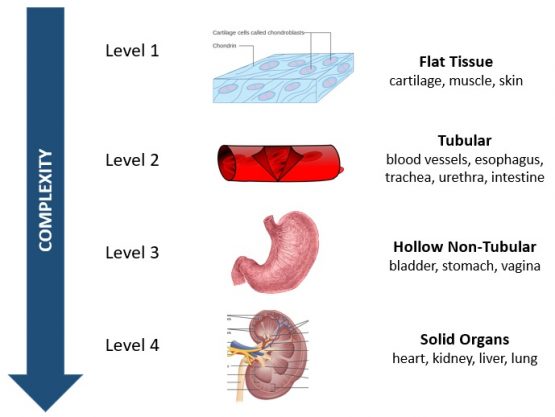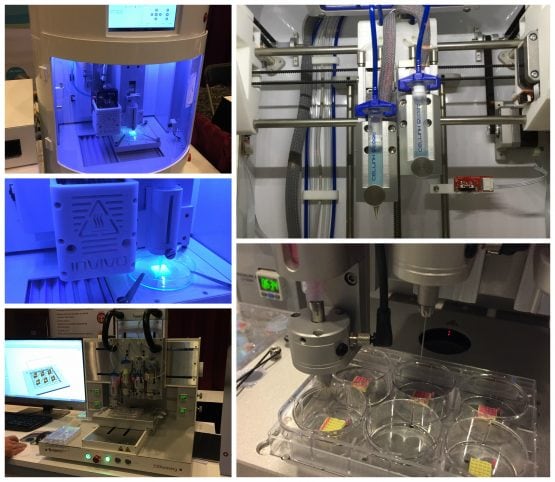The Wake Forest Institute of Regenerative Medicine (WFIRM) hosted about 400 attendees at the annual Biofabrication conference, held this year at Winston-Salem, NC (Oct 28-Nov 1, 2016). The conference included a 2 hour tour of WFIRM’s incredible facilities, 145 posters, 200 or so presentations and a small trade show with about 30 exhibitors. As a mechanical engineer attending my first bio-related conference, I struggled to fully comprehend many concepts and terms in some of the deeper technical presentations. Nonetheless, there was a lot I DID learn, and this post serves to summarize my thoughts on the four high-level insights I gleaned amidst the pile of information on offer. I hope these are of value to the larger community that is not on the front lines of this exciting and impactful area of research.
More than Organs
To say biofabrication is all about making organs is like saying manufacturing is all about making spacecrafts carrying humans to Mars. It misses a lot of the other valid human needs that can be met and suggests organs are the end of the biofabrication R&D curve, when they only represent one manifestation (arguably the most difficult one in our current sense of the world) of the application of the science. If we take a step back, biofabrication is fundamentally about “manufacturing with living materials” – in that sense, biofabrication blurs the lines between natural and man-made entities. If you could manipulate and engineer living cells in physical constructs, what all could you do? Here is a list of some examples of the different applications that were discussed at the conference:
- Toxicology Studies – Organovo’s examples of skin, liver and kidney tissue being used to evaluate drug efficacy
- Body-on-a-Chip – A solution to aid in pre-clinical work to study whole systems (a key regulatory hurdle) and potentially displace animal studies in the future
- Tissues for Therapy – This could involve patches, stents and other such fixes of a therapeutic nature (as opposed to replacing the entire organ in question)
- Non-Medical Applications – Modern Meadow is a company that is using biofabrication techniques to make leather and thereby help reduce our dependency on animal agriculture. Biofabricated meat is another potential application.
- Functional Tissues and Organs – An interesting thought presented by Prof. Rashid Bashir is that replacing organs with matched constructs may not be optimal – we may be able to develop biological entities that get the job done without necessarily replicating every aspect of the organ being replaced. A similar thought is to to use biological materials to do engineering tasks. The challenge with this approach is living cells need to be kept alive – this is easier done when the fabricated entity is part of a living system, but harder to do when it is independent of one.
- Full Organ Replacement – Replicating an organ in all its detail: structurally and functionally – WFIRM has done this for a few organs that they consider Level 1-3 in terms of complexity (see Figure 1). Level 4 organs (like the heart) are at the moment exceedingly challenging due to their needs for high vascularity and large size.

It Takes a Village (and a Vivarium)
Imagine this is the early 2000s and you are tasked with establishing a center dedicated to accelerating the progress of regenerative medicine. What are the parts this center needs to house? This was probably what Dr. Anthony Atala and others were working out prior to establishing WFIRM in 2004. To give you a sense of what goes on in WFIRM today, here is a (partial) list of the different rooms/groups we visited on our tour: decellularization, imaging, tissue maturation, bioprinting, electrospinning, lab-on-a-chip, direct writing, vivarium that cares for animals (mice, ferrets, sheep, pigs, dogs – beagles to be specific, and “non-human primates”) and a cleanroom for pre-clinical studies. Add administrative, outreach and regulatory staff. Today, about 450 people work at WFIRM and many more collaborate. Going into this conference, I was well aware this field was an inter-disciplinary one. The tour opened my eyes to just how many interdependent parts there are that make an end-to-end solution possible, some more interdisciplinary in nature than others and just how advantageous it must be to have all these capabilities under one roof dedicated to a larger mission instead of spread across a large university campus, serving many masters.
“I Have a Hammer, Where is the Nail?”
I will be honest – I justified my interest in biofabrication on the very dubious basis of my experience with 3D printing, a long standing interest in the life sciences that I had hitherto suppressed, and the fact that I am married to a cancer researching biochemist – bioprinting was my justification for finally getting my feet (close to a) wet (lab). I suspect I am not alone in this (support group, anyone?). When I described this to the only surgeon who entertains my questions, he accurately summarized my approach in the afore mentioned hammer-nail analogy. So, armed with my hammer, I headed to the biofabrication conference seeking nails. The good news is I found a couple. As in exactly two. The bad news? See the section above – this stuff is hard and multi-faceted – and there are folks with a multi-decade head start. So for those of us not on the front lines of this work or not in college planning our next move, the question becomes how best can we serve the scientists and engineers that are already in this field. Better tools are one option, and the trade show had examples of these: companies that make bioprinters (see Figure 2 below), improved nozzles for bioprinting, clean-room alternatives, biomaterials like hydrogels, and characterization and testing equipment. But solving problems that will help the biofabrication community is another approach and there were about 5-10 posters and
presentations (mine included) which attempted to do just that. What are some of the areas that could benefit from such peripheral R&D engagement? My somewhat biased feeling is that there is opportunity for bringing some of the same challenges Additive Manufacturing is going through to this area as well:
- Design for Bioprinting: fully exploiting the possibilities of bioprinting – “in Silico” has made some progress with medical devices – a similar window of value exists for biofabrication due to the design freedom of 3D printing
- Modeling: Biofabrication almost always involves multi-materials, often with varying constitutive behaviors and further are in complex, time-varying environments – getting some handle on this is a precursor to item 1 above
- Challenges of Scale: This has many elements: quality control, cost, automation, data security, bio-safety. This is one of the key drivers behind the recent DOD call for an Advanced Tissue Biofabrication Manufacturing Innovation Institute and is likely to drive several projects in this space over the next 5-7 years.
Moral of the story for me: carry your hammer with pride but take the time to learn, ask and probe to find the pain points that are either already there or are likely to arise in the future, and keep refining your hammer with input from the biofabrication community – conferences are the best place to do this – IF you go in with that intent and prepare ahead of time identifying the people you want to talk to and the questions you wish to ask them – something I hope to be better at next time around.

The Rate-of-Progress Paradox
Finally, a more abstract point. From the sidelines, we may ask how far has the field of biofabrication come and how fast is it progressing? It is one thing to sift through media hype and reconcile it with ground realities. It is quite another to discover this conflict seemingly exists even in the trenches – there are several examples of transplanted biofabricated entities, yet there is a common refrain that we have a long way to go to doing just so. And that struck me initially as a paradox as I heard the plenary talks that were alternatingly cautious and wild – but on the very last day I started to appreciate why this was not a paradox at all, it is just the nature of the science itself. Unlike a lot of engineering paradigms, there are limits to efficiencies that can be gained in the life sciences – and once these are gained (shared resources, improved methods etc.), success in one particular tissue or organ may not make the next one progress much faster. Take Wake Forest’s own commonly used approach for regenerative medicine, for example: harvest cells, culture them, build scaffold constructs, mature cells on these constructs, implant and monitor. Sounds simple, but takes 5-10 years to get to clinical implantation and another 5-10 of observation before the results are published. And just because you have shown this in one area, bladder for example, doesn’t make the next one much faster at all. All the same steps have to be followed: pathways to be re-evaluated, developmental studies to be done – prior to extensive animal and clinical trials. The solution? Pursue multiple tissues/organs in parallel, follow each step diligently and be patient. Wake Forest seems to have envisioned this over a decade ago and I expect the coming decade will show a cascade of biofabrication successes hit us with increasingly boring steadiness.
Concluding Thoughts
Finally, we should all be thankful to the many PhD students and post-docs from all over the world putting in the bulk of the disciplined, hard work this field demands, most of them, in my opinion, at salaries not reflective of their extensive education and societal value. We should also spare a thought for all the animals being sacrificed for this and other research, even in the context of best veterinary practices – my personal hope is that biofabrication enables us to stop all animal trials at some point in the near future – indeed, this seems to be the only technology that can. Then we can truly say with confidence, that we have first and foremost, done no harm.
Thank you WFIRM, for a wonderful conference and all the work you do everyday!


















